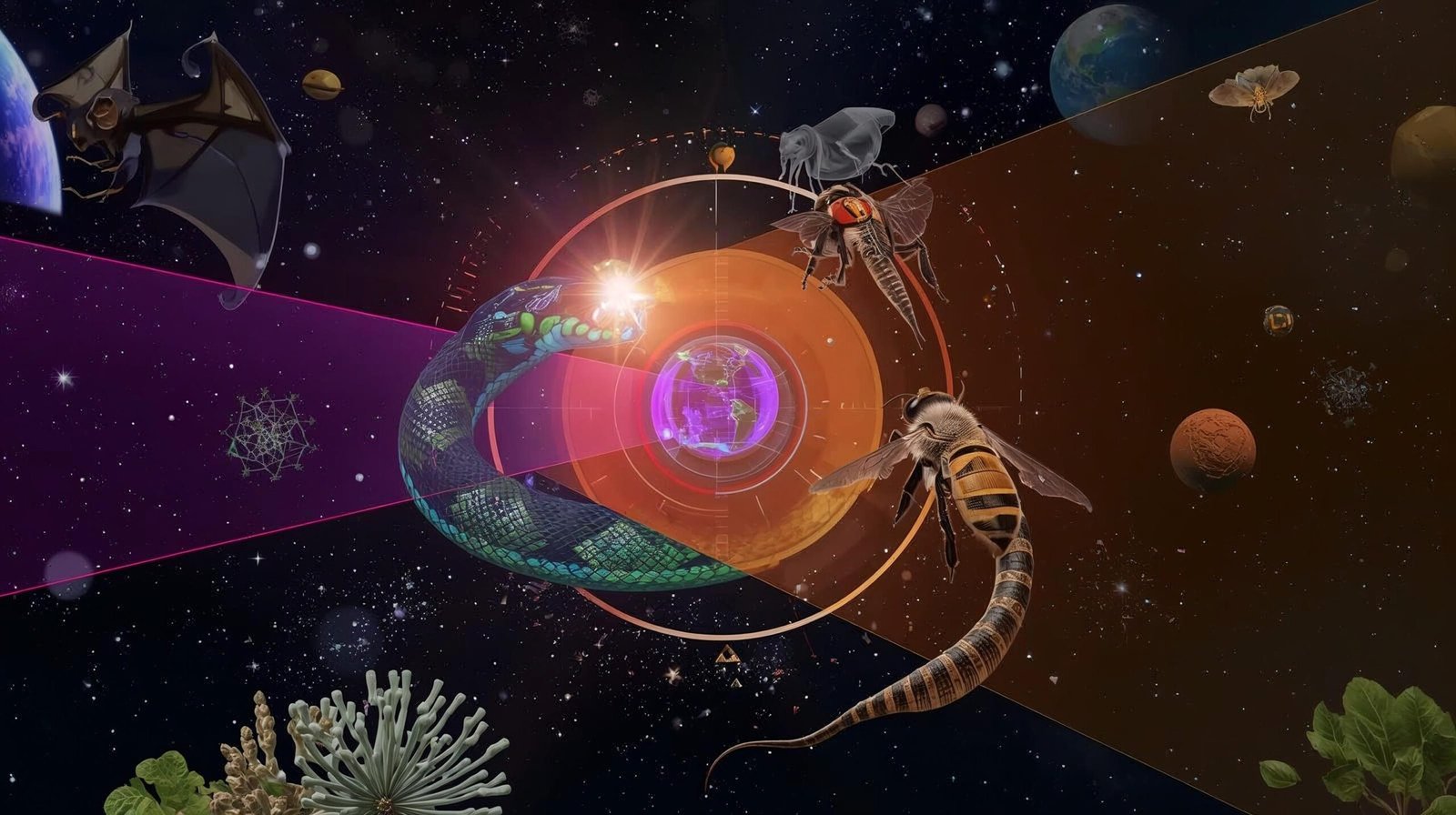An Immense World Summary: 11 Astonishing Lessons About How Animals Perceive Reality
Introduction
An Immense World Summary is a captivating journey through the sensory realms of animals — an exploration that transcends human imagination. Written by Pulitzer Prize-winning science journalist Ed Yong, this masterpiece reveals the hidden worlds that surround us, worlds we cannot see, hear, or feel, yet they exist vividly for other creatures.
If you have ever wondered how a bat perceives sound, how a dog detects emotion through scent, or how a bird navigates thousands of miles using magnetic fields, this book is a revelation. In An Immense World Summary, Ed Yong takes readers into the mysterious sensory “Umwelten” — the unique perceptual bubbles each species inhabits. This review distills the essence of his monumental work into 11 astonishing lessons, perfect for people in a hurry who want profound understanding without reading the full volume.

1. The Concept of Umwelt: A Universe Within Each Creature
At the core of An Immense World Summary lies the concept of Umwelt, a German term introduced by biologist Jakob von Uexküll. Umwelt refers to the sensory world experienced by an organism — its subjective reality. Every species, from bees to elephants, lives in a distinct bubble shaped by its senses.
For example, a tick’s universe revolves around temperature, smell, and light — three cues that help it find a host. A bird’s Umwelt may include ultraviolet vision, invisible to humans. This lesson teaches humility: the world as we perceive it is not the full picture.
2. Vision: Seeing Beyond Human Limits
Human eyes perceive a narrow slice of the electromagnetic spectrum. But in An Immense World Summary, Ed Yong demonstrates that animals extend far beyond these boundaries.
-
Bees see ultraviolet patterns that guide them to nectar.
-
Snakes detect infrared heat signatures.
-
Mantis shrimps can perceive polarized light and colors unimaginable to us.
By unveiling these visual marvels, the author reminds us that our eyes show only a fraction of reality. The animal kingdom’s visual world is far richer, stranger, and more magnificent.
3. Sound: The Invisible Waves of Communication
Another crucial dimension in An Immense World Summary is the soundscape of nature. For bats, dolphins, and whales, sound is not merely for communication — it is a tool for navigation and hunting.
-
Bats employ echolocation, interpreting echoes to construct mental maps.
-
Dolphins use sound pulses to “see” underwater.
-
Elephants communicate in infrasonic frequencies that travel miles.
Yong’s research opens a window into how animals live in symphonies of frequencies humans cannot hear. The silent world we perceive is, in reality, filled with vibrant acoustic life.
4. Smell and Taste: The Language of Invisible Molecules
In An Immense World Summary, the sense of smell and taste becomes a powerful language of survival. Dogs, for instance, can detect fear, disease, and even time itself through scent trails.
Ed Yong describes how scent is more than just recognition; it is an emotional and spatial experience.
-
Moths locate mates miles away by following pheromone clouds.
-
Salmon navigate back to their birthplace through the smell of their natal stream.
-
Humans, though comparatively poor in olfaction, still attach powerful memories to scents.
The invisible molecules that fill the air narrate endless stories — we simply lack the receptors to read them fully.
5. Touch and Vibration: Feeling the World in Silence
An Immense World Summary also explores tactile and vibrational perception — senses often overlooked. Spiders, for example, sense web vibrations to identify prey or courtship signals. Elephants feel seismic waves through their feet to communicate across vast distances.
For animals, touch is not confined to skin contact; it’s a medium of survival and intimacy. Yong’s vivid descriptions reveal that to many creatures, vibration is as meaningful as language.
6. Electric and Magnetic Senses: The Hidden Forces
One of the most mind-expanding sections of An Immense World Summary discusses how certain species sense forces invisible to humans. Sharks and rays detect weak electrical fields generated by prey. Migratory birds, sea turtles, and even some bacteria sense the Earth’s magnetic field — a biological compass that guides their movements.
These abilities are not science fiction; they are nature’s sophisticated navigation systems. Yong urges us to see these creatures not as strange anomalies but as masters of physics.

7. The Light of Darkness: The Gift of Nocturnal Perception
Many animals thrive where light barely exists. In An Immense World Summary, the author beautifully describes how owls, cats, and deep-sea fish dominate the darkness. Their eyes adapt with extraordinary sensitivity — using more rod cells, wider pupils, and reflective layers to capture minimal light.
Darkness, often feared by humans, is a playground for these creatures. Through Yong’s writing, we learn that night vision is not deficiency but adaptation — a triumph of evolution’s creativity.
8. Communication Beyond Words: Signals and Perception
Communication is central to survival, yet few humans understand how diverse it can be. An Immense World Summary shows that signals are not always vocal or visual. Fireflies communicate through light pulses; cuttlefish change skin patterns to express emotion; bees perform dances to share food locations.
Each act of signaling depends on the receiver’s Umwelt. What humans interpret as silence or stillness might be a bustling exchange in another creature’s sensory code.
9. The Human Blind Spot: The Illusion of Supremacy
In one of the most thought-provoking chapters of An Immense World Summary, Ed Yong challenges human arrogance. We often assume we are the pinnacle of perception, yet our senses are narrow and biased. Our awareness is bounded by biology.
By accepting this limitation, we gain wisdom. We learn that understanding nature demands humility — to listen beyond our frequencies, to see beyond our colors, and to feel beyond our skins.
10. Environmental Noise: The Tragedy of Sensory Pollution
An Immense World Summary also serves as a warning about sensory pollution. Human activities — urban noise, artificial lighting, chemical contamination — distort the natural signals animals depend on.
For instance:
-
City noise disrupts bird songs and mating calls.
-
Artificial lights disorient sea turtles and migrating birds.
-
Chemicals in water confuse olfactory cues for fish.
Yong reminds us that protecting biodiversity means preserving sensory worlds. Conservation is not just about saving habitats — it’s about saving perception itself.
11. The Awe of Empathy: Seeing Through Other Eyes
The final lesson in An Immense World Summary is about empathy through awareness. When we imagine the world as seen by an ant, heard by a bat, or smelled by a dog, we expand our consciousness.
This imaginative empathy is both scientific and spiritual. It teaches reverence for life in all its forms. As Yong eloquently writes, “To perceive the world through another’s senses is the beginning of compassion.”
The Beauty of Science and Storytelling
Beyond its scientific depth, An Immense World Summary stands out for its lyrical storytelling. Ed Yong transforms complex biology into poetic reflection. He does not merely describe facts — he invites readers to feel them.
His prose captures the wonder of existence. Through his writing, the invisible becomes visible, the inaudible becomes audible, and the impossible becomes intimate. It is a triumph of both intellect and imagination.

Key Takeaways from An Immense World Summary
-
Every species inhabits a unique sensory world (Umwelt).
-
Human perception is limited and biased by evolution.
-
Animals use diverse senses — from light and sound to magnetism and electricity.
-
Sensory pollution threatens the survival of many species.
-
Understanding other beings’ perception fosters empathy and respect.
An Immense World Summary is not merely a book about animals — it is a mirror reflecting humanity’s place in nature.
Why You Should Read An Immense World Summary
If you love science, nature, or philosophy, this book will change your worldview. It appeals to anyone curious about existence beyond the human lens. Ed Yong’s writing transforms biology into art, making every page an adventure through unseen realms.
Even if you are short on time, this summary delivers the essence — enlightening, humbling, and transformative. It reminds us that to truly know life, we must learn to see the world anew.
Beyond Human Boundaries: Rediscovering Reality Through An Immense World Summary
When reading An Immense World Summary, one cannot help but reflect on how small and partial our own perception truly is. The book does not simply describe animal senses; it shatters the illusion that the human experience of reality is complete. We often assume that the world we see, hear, and touch is the full truth. Yet, Ed Yong elegantly demonstrates that what we call “the world” is merely our version of it, filtered through the limits of our biology.
In a world governed by convenience and technology, humans have become increasingly detached from nature’s original design. We depend heavily on artificial light, digital sound, and virtual space. An Immense World Summary acts as a gentle reminder that the true world exists beyond our devices — in the vibrations of a spider’s web, in the scent trail of a fox, in the ultraviolet petals of a flower invisible to our eyes.
The Philosophy Behind Sensory Diversity
What makes An Immense World Summary so profound is that it merges biology with philosophy. Every sensory discovery invites a moral reflection. If each animal perceives a unique version of reality, then truth itself becomes plural, existing in infinite forms.
This realization humbles the human intellect. It suggests that knowledge is always relative to the observer. Just as a bee interprets ultraviolet colors humans cannot imagine, so too might there exist forms of understanding that transcend our cognitive boundaries.
Yong subtly implies that embracing this diversity of perception can cultivate empathy — a quality much needed in the human world. When we understand that every creature’s experience is valid and real in its own way, our compassion extends naturally. In that sense, An Immense World Summary is not only about animals; it is also about the moral evolution of humanity.
How Technology Echoes Nature’s Genius
One of the most surprising revelations in An Immense World Summary is how many modern technologies draw inspiration from animal senses. Engineers study bats to improve sonar systems, dolphins to refine underwater navigation, and mantis shrimps to design more accurate cameras.
Nature’s sensory genius, refined through millions of years of evolution, is the ultimate model of innovation. Yet, as Yong points out, humans often exploit this genius without fully appreciating it. The same animals that inspire scientific breakthroughs are endangered by human-created sensory pollution.
This paradox highlights a recurring theme in An Immense World Summary: the tension between admiration and disruption. We marvel at animal abilities, but we also interfere with the environments that sustain them. The book calls for a deeper form of coexistence — one based not on dominance, but on understanding.

Relearning to See the Invisible
Perhaps the greatest gift of An Immense World Summary is that it trains readers to see the invisible. Through Ed Yong’s vivid descriptions, the world begins to feel alive again — not as a static backdrop to human activity, but as a living, pulsating network of sensory exchange.
For instance, the author recounts how elephants can detect thunder hundreds of miles away through low-frequency vibrations. How bees perceive the polarization of light in the sky to navigate. How owls hear prey beneath layers of snow. Each example reminds us that our own sensory world is like a small island in a vast ocean of perception.
Reading An Immense World Summary is therefore not just an intellectual exercise; it is a spiritual awakening. It makes us aware of how little we perceive and how much beauty lies beyond our reach. It challenges the arrogance of assuming that only human senses define reality.
The Ethical Dimension: Living with Awareness
What responsibility follows from this knowledge? Ed Yong urges us to live more gently within the sensory worlds of others. Every artificial light we leave burning at night, every engine we allow to roar through forests, disturbs lives that depend on quietness, darkness, or subtle signals.
In An Immense World Summary, we are reminded that coexistence begins with respect. The more we understand the sensory lives of animals, the more careful we become with our impact. This is an ethical call to awareness — to think before we light up the sky, before we pollute the oceans with sound, before we flatten the earth’s textures into concrete monotony.
Such mindfulness is not just environmental activism; it is moral evolution. By recognizing other sensory realities, we expand the boundaries of empathy itself.
Science as a Bridge Between Worlds
Science often strives for objectivity, yet in An Immense World Summary, Ed Yong uses science as a bridge — connecting the objective with the emotional. His research becomes a vessel of wonder, carrying readers across invisible thresholds of reality.
He explains complex sensory systems with clarity, yet never loses poetic resonance. Each discovery becomes a story, each sense a language. He shows that the scientist and the poet, though different in method, share the same quest: to understand existence in all its mysterious depth.
The Reader’s Transformation
Those who finish An Immense World Summary are not the same as when they began. The book changes how one walks through life. A bird’s song becomes a coded message; a flower’s glow becomes an ultraviolet beacon. The ordinary world turns extraordinary.
Readers begin to notice small things — the hum of insects, the flicker of fish, the rhythm of rain — as if the world is whispering secrets we never paused to hear. That, perhaps, is Ed Yong’s ultimate gift: to awaken our dormant sense of wonder.
It is rare for a science book to touch both the mind and the heart with equal force. An Immense World Summary achieves this balance effortlessly, leaving the reader both enlightened and humbled.
A Lesson for the Modern World
In an age dominated by screens and algorithms, this book reclaims attention for the natural world. It reminds us that while we have extended our digital senses globally, we have simultaneously dulled our biological ones.
Our vision narrows to pixels, our hearing drowns in mechanical noise, and our sense of touch is mediated by glass. An Immense World Summary invites us back into authentic perception — to feel the textures of life, to smell the earth after rain, to hear the silence that surrounds songbirds.
When read slowly and thoughtfully, it becomes not just a science narrative, but a meditative experience — a manual for rediscovering the sacredness of awareness.

Frequently Asked Questions (FAQs)
1. What is the main idea of An Immense World Summary?
The book explores how animals perceive the world through their unique sensory systems, revealing that reality differs for every species.
2. Who is Ed Yong?
Ed Yong is a British science journalist and Pulitzer Prize winner, known for his engaging works on biology and science communication.
3. What does “Umwelt” mean in An Immense World Summary?
“Umwelt” is a German term describing the sensory world experienced by each organism — its personal version of reality.
4. Is An Immense World Summary suitable for general readers?
Yes. Though grounded in science, the book uses accessible language and vivid examples that make it enjoyable for everyone.
5. Why is sensory pollution discussed in the book?
Because human-created noise and light interfere with animal senses, disrupting communication, navigation, and survival.
6. How does this book change the way we see nature?
It teaches us to respect the diversity of perception and to realize that human experience is just one of countless sensory realities.
7. What genre is An Immense World Summary?
It belongs to science non-fiction, blending biology, environmental studies, and philosophy.
Conclusion
An Immense World Summary by Ed Yong is more than a scientific narrative — it is an awakening. It teaches that every living being exists within its own sensory cosmos, perceiving dimensions invisible to us.
By understanding these hidden realities, we grow in empathy and wonder. We learn that the planet is not built for human senses alone — it resonates with infinite forms of awareness.
If you wish to expand your imagination, nurture compassion, and rediscover the miracle of life, this book is a must-read. It challenges your perception and rewards you with a renewed sense of awe.
For more insightful book reviews and philosophical reflections, visit shubhanshuinsights.com — where words meet wisdom.